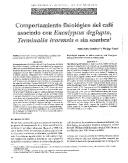| dc.description.abstract | El comportamiento fisiológico del café bajo Eucalyptus deglupta, Terminalia ivorensis y a pleno sol fue estudiado en las épocas seca y lluviosa en condiciones sub-óptimas en el sur de Costa Rica. La humedad del suelo en la época seca fue menor bajo T. ivorensis comparado con café bajo E. deglupta o a pleno sol, probablemente debido a una alta transpiración de T. ivorensis por sus mayores tasas de conductividad estomática en las horas del mediodía y de la tarde. La temperatura foliar del café fue generalmente superior a 27°C (por arriba del óptimo). En la mañana, la temperatura de las hojas del café bajo T. ivorensis fueron 4°C menores que a pleno sol, mientras que al mediodía esta diferencia fue de 2,4°C (bajo E. deglupta las diferencias fueron de 1,9 y 1,5°C). La tasa de asimilación neta de CO2 de hojas de café mostró un patrón similar a pleno sol y bajo E. deglupta, ya que las máximas tasas se observaron en la mañana y disminuyeron a lo largo del día. Al contrario bajo T. ivorensis, las mayores tasas de asimilación de café se alcanzaron en las horas del mediodía debido a una Radiación Fotosintéticamente Activa (RAFA) baja. La conductividad estomática de hojas de café fue más alta bajo E. deglupta que bajo T. ivorensis debido a una mayor RAFA y fue también más alta que a pleno sol debido a menores temperaturas foliares. Estos resultados respaldan la decisión empírica de los agricultores de la zona en preferir E. deglupta en comparación a T. ivorensis como árbol maderable de sombra para café. The physiological response of coffee growing under Eucalyptus deglupta, Terminalia ivorensis and full sun was studied during the dry and rainy seasons in sub-optimal conditions in the southern part of Costa Rica. During the dry season, soil humidity was lower under T. ivorensis compared with coffee below E. deglupta or without shade, probably due to high transpiration rates of T. ivorensis due to higher stomatal conductance at midday and in the afternoon. Coffee leaf temperatures were generally higher than 27°C (above optimal). In the morning, leaf temperatures of coffee under T. ivorensis 4°C lower than unshaded plants, while at noon this difference was 2.4°C (under E. deglupta the differences were 1.9 and 1.5 °C). The rates of net CO2 assimilation of coffee leaves under full sun and E. deglupta were similar higher rates were observed in the morning and diminished during the day. In contrast, under T. ivorensis, the highest rates of coffee assimilation were reached only around noon due to low Photosintetic Active Radiation (PAR). The stomatal conductance of coffee under E. deglupta was higher than that under T. ivorensis due to a higher temperatures. These results support the empirical decision of coffee farmers in the zone of preferring E. deglupta vs. T. ivorensis as a timber shade tree for coffee. | es_ES |


